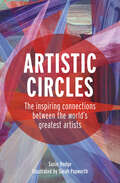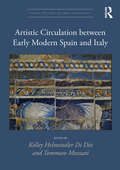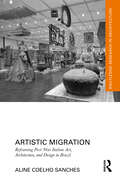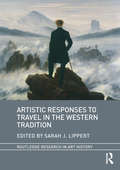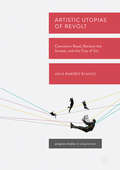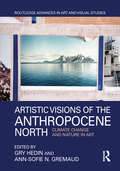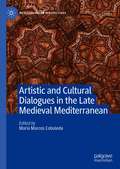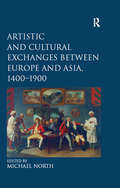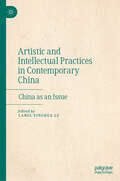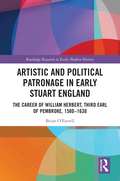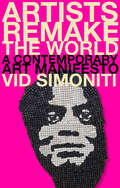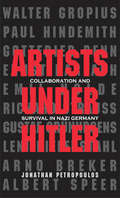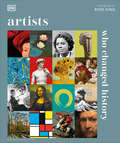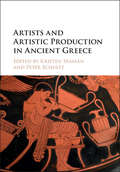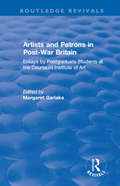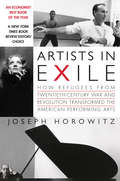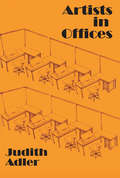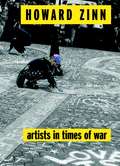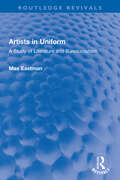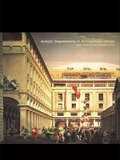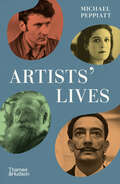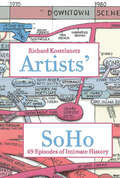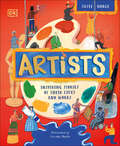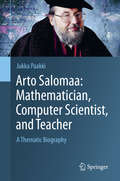- Table View
- List View
Artistic Circles: The Inspiring Connections Between the World's Greatest Artists
by Susie HodgeDiscover the fascinating connections between the world's greatest artists. Artistic Circles introduces some of the most inspirational stories of friendship, love, creativity and shared passions in the world of art. Whether through teaching, as in the case of Paul Klee and Anni Albers; a mutual muse, as seen in the flowers of Georgia O&’Keeffe and Takashi Murakami; or an inspirational romantic coupling like that of Lee Krasner and Jackson Pollock. In telling the tales of these creatives lives and achievements – each extraordinary and oftentimes ground-breaking – Susie Hodge exposes the fascinating web of connections that have fostered some of the world&’s art masterpieces. Some are well-known, whereas others span both time and place, linking pioneers in art in fascinating and unexpected ways. Illustrated in colourful tribute to each artists&’ unique style, Artistic Circles is an illuminating and celebratory account of some of the art world&’s most compelling visionaries. A perfect introduction for students, and a source of new and surprising stories for art lovers.
Artistic Circulation between Early Modern Spain and Italy (Visual Culture in Early Modernity)
by Kelley Helmstutler Di Dio Tommaso MozzatiThis collection of essays by major scholars in the field explores how the rich intersections between Italy and Spain during the early modern period resulted in a confluence of cultural ideals. Various means of exchange and convergence are explored through two main catalysts: humans—their trips or resettlements—and objects—such as books, paintings, sculptures, and prints. The visual and textual evidence of the transmission of ideas, iconographies and styles are examined, such as triumphal ephemera, treatises on painting, the social status of the artist, collections and their display, church decoration, and funerary monuments, providing a more nuanced understanding of the exchanges of styles, forms and ideals across southern Europe.
Artistic Migration: Reframing Post-War Italian Art, Architecture, and Design in Brazil (Routledge Research in Architecture)
by Aline Coelho SanchesArtistic Migration: Reframing Post-War Italian Art, Architecture, and Design in Brazil investigates a selection of works by Italian artists and architects, and an art critic and dealer, who immigrated to Brazil after World War II, and were involved in the first activities and opportunities created by the São Paulo Museum of Art (MASP).Although foreigners, these experts, namely Bramante Buffoni, Roberto Sambonet, Lina Bo Bardi, Giancarlo Palanti, and Pietro Maria Bardi, were engaged in the construction of paths for Brazilian art, architecture, and design, in production marked by the intertwining of artistic disciplines. By examining the works produced between 1946 and 1991, and focusing on the relationship between art and architecture, with previously unexplored cases, the text investigates how these actors engaged in the dilemmas of Brazilian culture and became part of its invention. The intention is to understand the nature and meaning of this recognizable experience, the continuities of and ruptures from modern architectural, art and design ideals, pre-war experience, and immigration, illuminating a complex framework of relationships with local ideas.The approach and the extensive archival research in Italy and Brazil adopted for the book sheds new light on critically rethinking and reframing Italian and Brazilian cultural events, and will be of interest to architects, researchers, teachers, and students interested in the history of architecture, museums, design, and art.
Artistic Responses to Travel in the Western Tradition (Routledge Research in Art History)
by Sarah J. LippertIn an era when ease of travel is greater than ever, it is also easy to overlook the degree to which voyages of the body – and mind – have generated an outpouring of artistry and creativity throughout the ages. Exploration of new lands and sensations is a fundamental human experience. This volume in turn provides a stimulating and adventurous exploration of the theme of travel from an art-historical perspective. Topical regions are covered ranging from the Grand Tour and colonialism to the travels of Hadrian in ancient times and Georgia O’Keeffe’s journey to the Andes; from Vasari’s Neoplatonic voyages to photographing nineteenth-century Japan. The scholars assembled consider both imaginary travel, as well as factual or embellished documentation of voyages. The essays are far-reaching spatially and temporally, but all relate to how art has documented the theme of travel in varying media across time and as illustrated and described by writers, artists, and illustrators. The scope of this volume is far-reaching both chronologically and conceptually, thereby appropriately documenting the universality of the theme to human experience.
Artistic Utopias of Revolt: Claremont Road, Reclaim the Streets, and the City of Sol (Palgrave Studies in Utopianism)
by Julia Ramírez BlancoThis book analyses the aesthetic and utopian dimensions of various activist social movements in Western Europe since 1989. Through a series of case studies, it demonstrates how dreams of a better society have manifested themselves in contexts of political confrontation, and how artistic forms have provided a language to express the collective desire for social change.<p><p> The study begins with the 1993 occupation of Claremont Road in east London, an attempt to prevent the demolition of homes to make room for a new motorway. In a squatted row of houses, all available space was transformed and filled with elements that were both aesthetic and defensive – so when the authorities arrived to evict the protestors, sculptures were turned into barricades. At the end of the decade, this kind of performative celebration merged with the practices of the antiglobalisation movement, where activists staged spectacular parallel events alongside the global elite’s international meetings. As this book shows, social movements try to erase the distance that separates reality and political desire, turning ordinary people into creators of utopias. Squatted houses, carnivalesque street parties, counter-summits, and camps in central squares, all create a physical place of these utopian visions
Artistic Visions of the Anthropocene North: Climate Change and Nature in Art (Routledge Advances in Art and Visual Studies)
by Gry Hedin Ann-Sofie N. GremaudIn the era of the Anthropocene, artists and scientists are facing a new paradigm in their attempts to represent nature. Seven chapters, which focus on art from 1780 to the present that engages with Nordic landscapes, argue that a number of artists in this period work in the intersection between art, science, and media technologies to examine the human impact on these landscapes and question the blurred boundaries between nature and the human. Canadian artists such as Lawren Harris and Geronimo Inutiq are considered alongside artists from Scandinavia and Iceland such as J.C. Dahl, Eija-Liisa Ahtila, Toril Johannessen, and Björk.
Artistic and Cultural Dialogues in the Late Medieval Mediterranean (Mediterranean Perspectives)
by María Marcos CobaledaThis book analyses the artistic and cultural legacy of Western Islamic societies and their interactions with Islamic, Christian and Jewish societies in the framework of the late medieval Mediterranean, from a range of multi-disciplinary perspectives. The book, organised in four parts, addresses the Andalusi legacy from its presence in the East and the West; analyses the relations and transfers between Al-Andalus and the artistic productions of the Christian kingdoms of the Iberian Peninsula; explores other manifestations of the Andalusi legacy in the fields of knowledge, construction, identity and religious studies; and reconsiders ornamental transfers and exchanges in artistic manifestations between East and West across the Mediterranean basin.Chapter 2 is open access under a CC BY 4.0 license.
Artistic and Cultural Exchanges between Europe and Asia, 1400-1900: Rethinking Markets, Workshops and Collections
by Michael NorthThe European expansion to Asia was driven by the desire for spices and Asian luxury products. Its results, however, exceeded the mere exchange of commodities and precious metals. The meeting of Asia and Europe signaled not only the beginnings of a global market but also a change in taste and lifestyle that influences our lives even today. Manifold kinds of cultural transfers evolved within a market framework that was not just confined to intercontinental and intra-Asiatic trade. In Europe and Asia markets for specific cultural products emerged and the transfers of objects affected domestic arts and craft production. Traditionally, relations between Europe and Asia have been studied in a hegemonic perspective, with Europe as the dominant political and economic centre. Even with respect to cultural exchange, the model of diffusion regarded Europe as the centre, and Asia the recipient, whereby Asian objects in Europe became exotica in the Kunst- und Wunderkammern. Conceptions of Europe and Asia as two monolithic regions emerged in this context. However, with the current process of globalization these constructions and the underlying models of cultural exchange have come under scrutiny. For this reason, the book focuses on cultural exchange between different European and Asian civilizations, whereby the reciprocal complexities of cultural transfers are at the centre of observation. By investigating art markets, workshops and collections in Europe and Asia the contributors exemplify the varieties of cultural exchange. The book examines the changing roles of Asian objects in European material culture and collections and puts a special emphasis on the reception of European visual arts in colonial settlements in Asia as well as in different Asian societies.
Artistic and Intellectual Practices in Contemporary China: China as an Issue
by Carol Yinghua LuThis edited volume is the first internationally available English translation of key lectures and essays delivered at Beijing’s Inside Out Art Museum over the past decade. The book elevates a chorus of voices from domestic and international intellectuals, artists, curators, and historians in a dialogue that reframes Chinese art from 1949 to the present.Part I offers critical academic complications of the story of Chinese art from the 1950s to the present as one singularly defined and stifled by political revolution. It traces important continuities and early examples of contemporary art practice to the Party’s birth and consolidation of power from the 1920s onwards. It relates the formation of contemporary art to the historical course of intellectual practice in China from 1949. Part II proposes China as an “issue” requiring historical interrogation rather than an inviolable entity. It questions the efficacy of “Asia” as a term, presents case studies of independentpublishers that challenged tightly crafted historical narratives, and wraps up with incisive reflections on the challenges confronting creatives and historians in China today.With chapters ranging from peer-reviewed scholarship to cuttingly humorous personal anecdotes, its contributing authors give rare, first-hand accounts of navigating pertinent historical and current situations, including censorship, China’s il/liberalism, and COVID-19. This book offers readers an ear to heretofore closed-door conversations in leading modern and contemporary art spaces.
Artistic and Political Patronage in Early Stuart England: The Career of William Herbert, Third Earl of Pembroke, 1580-1630
by Brian O'FarrellArtistic and Political Patronage in Early Stuart England explores the remarkable life and career of William Herbert, Third Earl of Pembroke. Pembroke was one of the most influential aristocrats during the reigns of Elizabeth I, James I and Charles I. He was a great patron, a prominent politician and electoral manager, an entrepreneur, and a gifted poet. Yet despite his influence and many talents, Pembroke’s life has been little studied by historians. Drawing on archival material, this book throws new light on Pembroke, and demonstrates just how significant he was during his lifetime. This book will appeal to scholars and students of early modern British history, as well as those interested in politics and patronage during the sixteenth and seventeenth centuries.
Artists Remake the World: A Contemporary Art Manifesto
by Vid SimonitiAn original and provocative exploration of the relationship between contemporary art, politics, and activism Artists Remake the World introduces readers to the political ambitions of contemporary art in the early twenty-first century and puts forward a new, wide-ranging account of art&’s political potential. Surveying such innovations as evidence-driven art, socially engaged art, and ecological art, the book explores how artists have attempted to offer bold solutions to the world&’s problems. Vid Simoniti offers original perspectives on contemporary art and its capacity as a force for political and social change. At its best, he argues, contemporary art allows us to imagine utopias and presents us with hard truths, which mainstream political discourse cannot yet articulate. Covering subjects such as climate change, social justice, and global inequality, Simoniti introduces the reader to a host of visionary contemporary artists from across the globe, including Ai Weiwei, Olafur Eliasson, Wangechi Mutu, Naomi Rincón Gallardo, and Hito Steyerl. Offering a philosophy of contemporary art as an experimental branch of politics, the book equips the reader with a new critical apparatus for thinking about political art today.
Artists Under Hitler
by Jonathan Petropoulos#147;What are we to make of those cultural figures, many with significant international reputations, who tried to find accommodation with the Nazi regime?” Jonathan Petropoulos asks in this exploration of some of the most acute moral questions of the Third Reich. In his nuanced analysis of prominent German artists, architects, composers, film directors, painters, and writers who rejected exile, choosing instead to stay during Germany’s darkest period, Petropoulos shows how individuals variously dealt with the regime’s public opposition to modern art. His findings explode the myth that all modern artists were anti-Nazi and all Nazis anti-modernist. Artists Under Hitler closely examines cases of artists who failed in their attempts to find accommodation with the Nazi regime (Walter Gropius, Paul Hindemith, Gottfried Benn, Ernst Barlach, Emil Nolde) as well as others whose desire for official acceptance was realized (Richard Strauss, Gustaf Gründgens, Leni Riefenstahl, Arno Breker, Albert Speer). Collectively these ten figures illuminate the complex cultural history of Nazi Germany, while individually they provide haunting portraits of people facing excruciating choices and grave moral questions.
Artists Unframed
by Merry ForrestaTucked away among the letters, diaries, and other ephemera in the Smithsonian's archives lies a trove of rarely seen snapshots of some of the twentieth century's most celebrated artists. Unlike the familiar official portraits and genius-at-work shots, these humble snaps capture creative giants with their guard down, in the moment, living life. Pablo Picasso stands proudly on a balcony with young daughter Maya--a tiny, meticulously inked annotation penned by an unknown hand proclaims that "he's very much in love." Jackson Pollock morosely carves a turkey while his mother, Stella, and wife, Lee Krasner, look on. A young Andy Warhol clowns for the camera with college friend Philip Pearlstein, and in a later shot more closely resembles his famously enigmatic public self at a gallery opening with John Lennon and Yoko Ono.
Artists Who Changed History (DK History Changers)
by DKThis visual celebration of the world's most celebrated thinkers tells the fascinating stories of their lives and pioneering ideas.Artists Who Changed History places well-known artists in their historical and cultural context, showing you how they came to influence Art as we know it today. This illustrated guide is ideal for those interested in art, sculptures, and the history of art or who would like to broaden their general understanding of art and the lives of artists.Inside this book on artists, you’ll find:-An overview of the lives and works of around 80 of the world's most influential artists - Middle Ages to the present day-Eight pages of brand-new content with 12 new entries, including Judith Leyster and Frank Bowling-Lavishly illustrated portraits of each artist alongside photographs of their homes and studios, original sketches, notebooks, lettersIn this Art guide, each artist is introduced with a realistic portrait and biographical entries that trace the friendships, loves, and rivalries that inspired and influenced them. Entries explore each individual's key ideas and working methods and set their ideas in context, conveying a powerful sense of the place and the period of history in which they lived. Artists Who Changed History provides revealing insights into what drove each individual to develop new ways of understanding the world.
Artists and Artistic Production in Ancient Greece
by Kristen Seaman Peter SchultzGreek artists and architects were important social agents who played significant roles in the social, cultural, and economic life of the ancient Greek world. In Artists and Artistic Production in Ancient Greece, art historians, archaeologists, and historians explore the roles and impacts of artists and craftsmen in ancient Greek society. The contributing authors draw upon artistic, architectural, literary, epigraphical, and historical evidence to discuss a range of artists, architects, artistic media, and regions. They refer to historiography and modern theory, taking stock of the past while offering some new directions for future research. Incorporating a variety of methodological approaches and making use of often-neglected evidence, Artists and Artistic Production in Ancient Greece re-examines many long-held ideas and provides a deeper understanding of particular artists and architects, their works, and their social agency.
Artists and Patrons in Post-war Britain
by Courtauld Institute of ArtThis title was first published in 2001. An examination of art and patronage in Britain during the post-war years. It consists of five case studies, initially written as MA theses, that closely investigate aspects of the mechanisms of patronage outside the state institutions, while indicating structural links within it. The writers have sought to elucidate the relationship between patronage, the production of art and its dissemination. Without seeking to provide an inclusive account of patronage or art production in the early post-war years, their disparate and highly selective papers set up models for the structure of patronage under specific historical conditions. They assume an understanding that works of art are embedded in their social contexts, are products of the conditions under which they were produced, and that these contexts and conditions are complex, fluid and imbricated in one another.
Artists in Exile
by Joseph HorowitzDuring the first half of the twentieth century--decades of war and revolution in Europe--an "intellectual migration" relocated thousands of artists and thinkers to the United States, including some of Europe's supreme performing artists, filmmakers, playwrights, and choreographers. For them, America proved to be both a strange and opportune destination. A "foreign homeland" (Thomas Mann), it would frustrate and confuse, yet afford a clarity of understanding unencumbered by native habit and bias. However inadvertently, the condition of cultural exile would promote acute inquiries into the American experience. What impact did these famous newcomers have on American culture, and how did America affect them? George Balanchine, in collaboration with Stravinsky, famously created an Americanized version of Russian classical ballet. Kurt Weill, schooled in Berlin jazz, composed a Broadway opera. Rouben Mamoulian's revolutionary Broadway productions of Porgy and Bess and Oklahoma! drew upon Russian "total theater." An army of German filmmakers--among them F. W. Murnau, Fritz Lang, Ernst Lubitsch, and Billy Wilder--made Hollywood more edgy and cosmopolitan. Greta Garbo and Marlene Dietrich redefined film sexuality. Erich Korngold upholstered the sound of the movies. Rudolf Serkin inspirationally inculcated dour Germanic canons of musical interpretation. An obscure British organist reinvented himself as "Leopold Stokowski." However, most of these gifted émigrés to the New World found that the freedoms they enjoyed in America diluted rather than amplified their high creative ambitions.A central theme of Joseph Horowitz's study is that Russians uprooted from St. Petersburg became "Americans"--they adapted. Representatives of Germanic culture, by comparison, preached a German cultural bible--they colonized. "The polar extremes," he writes, "were Balanchine, who shed Petipa to invent a New World template for ballet, and the conductor George Szell, who treated his American players as New World Calibans to be taught Mozart and Beethoven." A symbiotic relationship to African American culture is another ongoing motif emerging from Horowitz's survey: the immigrants "bonded with blacks from a shared experience of marginality"; they proved immune to "the growing pains of a young high culture separating from parents and former slaves alike."
Artists in Offices: An Ethnography of an Academic Art Scene
by Judith E. AdlerUniversities have become important sources of patronage and professional artistic preparation. With the growing academization of art instruction, young artists are increasingly socialized in bureaucratic settings, and mature artists find themselves working as organizational employees in an academic setting. As these artists lose the social marginality and independence associated with an earlier, more individual aesthetic production, much cultural mythology about work in the arts becomes obsolete.This classic ethnography, based on fieldwork and interviews carried out at the California Institute of the Arts in the 1980s, analyzes the day-to-day life of an organization devoted to work in the arts. It charts the rise and demise of a particular academic art "scene," an occupational utopian community that recruited its members by promising them an ideal work setting.Now available in paperback, it offers insight into the worlds of art and education, and how they interact in particular settings. The nature of career experience in the arts, in particular its temporal structure, makes these occupations particularly receptive to utopian thought. The occupational utopia that served as a recruitment myth for the particular organization under scrutiny is examined for what it reveals about the otherwise unexpressed impulses of the work world.
Artists in Times of War (Open Media Series)
by Howard Zinn"Political power," says Howard Zinn, "is controlled by the corporate elite, and the arts are the locale for a kind of guerrilla warfare in the sense that guerrillas look for apertures and opportunities where they can have an effect." In Artists in Times of War, Zinn looks at the possibilities to create such apertures through art, film, activism, publishing and through our everyday lives. In this collection of four essays, the author of A People's History of the United States writes about why "To criticize the government is the highest act of patriotism." Filled with quotes and examples from the likes of Bob Dylan, Mark Twain, e. e. cummings, Thomas Paine, Joseph Heller, and Emma Goldman, Zinn's essays discuss America's rich cultural counternarratives to war, so needed in these days of unchallenged U.S. militarism.
Artists in Uniform: A Study of Literature and Bureaucratism (Routledge Revivals)
by Max EastmanFirst published in 1934, Artists in Uniform confronts what the author describes as ‘two of the worst features of the Soviet experiment’ following Lenin’s death – bigotry and bureaucratism – and shows how they have functioned in the sphere of arts and letters. It is divided into three parts: The Artist’s International; A Literary Inquisition; and Art and the Marxian Philosophy.
Artists' Impressions in Architectural Design: Null
by Bob Giddings Margaret HorneArtists' Impressions in Architectural Design analyses the ways in which architects have presented their designs for clients and the public, both historically and contemporarily. It spans a period from the fifteenth to the twenty-first century.Architects have become familiar with change. The passage of time has brought with it new and revived styles of architecture, as well as innovative tools and techniques for their representation. The result is that while some methods show a view of the architect's concept for a building, others offer an almost real experience of the intended architecture. This book provides a rare and valuable study in which the exciting technological developments of today are placed in context with the rich heritage of the past. It offers an opportunity to learn how architects have chosen to represent their ideas. The authors dare to glimpse into the future and hopefully offer some reassurance for tomorrow.
Artists' Lives
by Michael PeppiattEngaging encounters, personal anecdotes, and jargon-free critical insights into some of the liveliest creative minds in modern art, by an international art-world insider. Praised by The Art Newspaper as “the best art writer of his generation,” Michael Peppiatt has encountered many European modern artists over more than fifty years. This selection of some of his best biographical writing covers a wide spectrum of modern art, from Van Gogh and Pierre Bonnard, to conversations with painter Sonia Delaunay, artist and photographer Dora Maar, who was Picasso’s lover in the 1930s and 1940s, and Francis Bacon, perhaps the most famous of the many artists with whom Peppiatt has formed personal friendships. Michael Peppiatt’s lively, engaging writing introduces us to many notable art-world personalities, such as the Catalan painter Antoni Tàpies, whom he visits in his studio, and moments of disillusion, such as his meeting with the self-mythologizing artist Balthus. Art criticism blends with anecdote: Peppiatt recalls riding with Lucian Freud in his Bentley, drinking with Bacon in Soho, and many more revealing moments. This collection of Peppiatt’s most perceptive texts includes encounters with underrecognized artists, such as Dachau survivor Zoran Mušic, or Montenegrin artist Dado, whose retrospective Peppiatt curated at the 2009 Venice Biennale. Remarkably varied in their scope and lucidly written for a general reader, these selected essays not only provide us with perceptive commentary and acute critical judgment, they also give a unique personal insight into some of the greatest creative minds of the modern era. This book is a must-read for all lovers of modernism and post-war paintingin particular.
Artists' SoHo: 49 Episodes of Intimate History
by Richard KostelanetzDuring the 1960s and 1970s in New York City, young artists exploited an industrial wasteland to create spacious studios where they lived and worked, redefining the Manhattan area just south of Houston Street. Its use fueled not by city planning schemes but by word-of-mouth recommendations, the area soon grew to become a world-class center for artistic creation—indeed, the largest urban artists’ colony ever in America, let alone the world.Richard Kostelanetz’s Artists’ SoHo not only examines why the artists came and how they accomplished what they did but also delves into the lives and works of some of the most creative personalities who lived there during that period, including Nam June Paik, Robert Wilson, Meredith Monk, Richard Foreman, Hannah Wilke, George Macuinas, and Alan Suicide. Gallerists followed the artists in fashioning themselves, their homes, their buildings, and even their streets into transiently prominent exhibition and performance spaces.SoHo pioneer Richard Kostelanetz’s extensively researched intimate history is framed within a personal memoir that unearths myriad perspectives: social and cultural history, the changing rules for residency and ownership, the ethos of the community, the physical layouts of the lofts, the types of art produced, venues that opened and closed, the daily rhythm, and the gradual invasion of “new people.” Artists’ SoHo also explores how and why this fertile bohemia couldn’t last forever. As wealthier people paid higher prices, galleries left, younger artists settled elsewhere, and the neighborhood became a “SoHo Mall” of trendy stores and restaurants.Compelling and often humorous, Artists’ SoHo provides an analysis of a remarkable neighborhood that transformed the art and culture of New York City over the past five decades.
Artists: Inspiring Stories of Their Lives and Works (DK Explorers)
by DKExtraordinary reference book of over 80 famous painters, their lives, their loves and their iconic paintings.This art book includes insightful biographies of artists accompanied with remarkable reproductions of their famous artworks. Begin with the early Renaissance and follow art movements through the centuries to some of the most well-known artists alive today.A gorgeous exploration of the defining people of the art world including pioneers like Giotto and Jan van Eyck, the greats like Leonardo da Vinci and Raphael, and the visionaries like Frida Kahlo and Hokusai. The large format art book is overflowing with information and pictures of your favorite classics. The full-page prints are especially spectacular, allowing you to get the full effect of the work that inspired, defined and encapsulated art movements.Over 500 years of the craft is discussed, with the chapters organized by century starting with "Before 1500&” and ending with &“1945 – Present.&” Each chapter features the relevant painters of those years with its own directory. Read about the historical context of art movements in sections which include timelines and fact panels giving incredible insight into the art world, the past lives of artists and their visions and techniques. Discover the unconventional stories of the artists' lives, including their influences, developments, friendships, loves and rivalries. Read about the portraits that Holbein did for Henry VIII to play matchmaker, Caravaggio's astonishing reaction to a badly cooked artichoke and the many romantic affairs of Picasso. Sometimes scandalous and often tumultuous, the lives of artists like Raphael, Hogarth, van Gogh, O'Keeffe, Magritte, Warhol and Kiefer are as interesting and captivating as their work. The Artists Behind the Paint BrushesA beautiful coffee table book that would make a lovely gift for those interested in art history and artist biographies, or to browse the attractive reproductions of the famous artworks. Includes a foreword by Ross King, who is the author of the bestselling Brunelleschi's Dome and Michelangelo and the Pope's Ceiling, as well as the novels Ex-Libris and Domino. • Over 80 biographies of the standout artists over the centuries since the early Renaissance. • Beautiful reproductions of artworks that allow you to get up close to their brush strokes. • Insight into historical art themes and movements that influenced the periods.
Arto Salomaa: A Thematic Biography
by Jukka PaakkiThis book outlines the scientific career of Arto Salomaa, a pioneer in theoretical computer science and mathematics. The author first interviewed the subject and his family and collaborators, and he then researched this fascinating biography of an intellectual who was key in the development of these fields.Early chapters progress chronologically from Academician Salomaa's origins, childhood, and education to his professional successes in science, teaching, and publishing. His most impactful direct research efforts have been in the areas of automata and formal languages. Beyond that he has influenced many more scientists and professionals through collaborations, teaching, and books on topics such as biocomputing and cryptography. The author offers insights into Finnish history, culture, and academia, while historians of computer science will appreciate the vignettes describing some of the people who have shaped the field from the 1950s to today. The author and his subject return throughout to underlying themes such as the importance of family and the value of longstanding collegial relationships, while the work and achievements are leavened with humor and references to interests such as music, sport, and the sauna.
